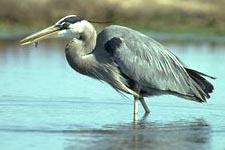Wildlife

Great Blue Heron
Scientific Name: Ardea herodias
Audio: Listen Now
Primary Source: Robert Naumann
Photo Source: Unknown
Audio Source: Unknown
More Info: USDA Forest Service
The great blue heron is the largest of the heron family in North America (measuring approximately 4ft in height). Heron habitats include rivers, lake edges, marshes, and swamps. This means you'll most often find them watching quietly or wading carefully in the quiet shallows of Bingen Lake, the far eastern portions of Bingen Harbor, or along the shores of the Columbia river.
These giant birds "fish" for their next meal during the day and into the night with most activity occurring around dawn and dusk. The heron uses its long legs to wade in shallow water and its sharp spear-like bill to catch its food. It spends nearly 90% of its active day foraging for food including fish, frogs, salamanders, lizards, snakes, shrimp, crabs, crayfish, dragonflies, grasshoppers, and other aquatic insects.
Herons build large saucer-shaped nests in groups called "colonies" and most often in stands of tall trees near the water. Nests are made of branches and twigs, are built by the female, and are often used year after year. Breeding typically occurs during the months of March through May in its northern range.
The female generally lays a clutch of 3 to 7 eggs which are cared for by both the male and female. Eggs usually hatch in 25 to 29 days and the young will be ready to fly 56 to 60 days after that.

